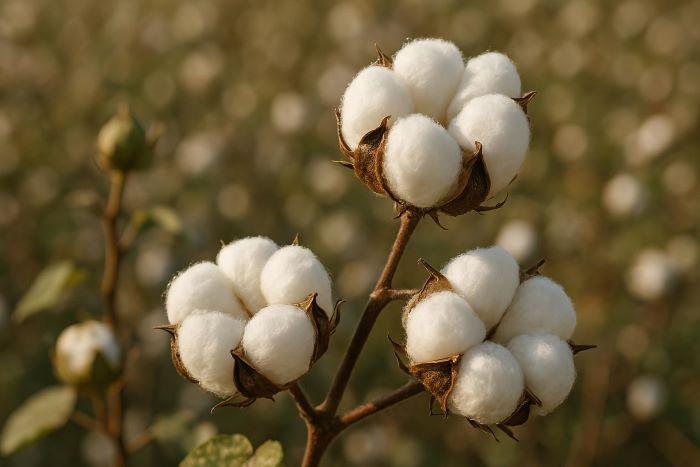With more than 12 million hectares under cultivation, India accounts for about 25% of the world's cotton production, making it the largest producer in the world. Notwithstanding its dominance, the industry deals with insect resistance, fragmented productivity, and shifting climatic trends. Whether India's cotton farming ecology is prepared for significant change is becoming increasingly crucial as calls for a second Green Revolution grow.
Cotton was omitted from the initial Green Revolution, which was based on high-yielding rice and wheat types. The question is whether cotton farming can advance past Bt technology and become a farmer-centric, data-driven, climate-resilient system.
Where Does Indian Cotton Farming Stand Today?
Various short, medium, and long-staple cotton types are grown in India. More than 90 percent of the overall planted land comprises hybrid cotton. However, compared to Brazil or China, where yields surpass 1,500 kg/ha, the average national yield is still below 500 kg/ha.
Challenges in the current landscape include:
- Widespread pink bollworm resistance to Bt traits.
- Dependence on rain-fed agriculture for over 65% of cotton fields.
- Fragmented landholding patterns reduce the scalability of best practices.
Even though BT cotton adoption began in 2002, innovation has been incremental. Input-intensive practices, overuse of pesticides, and poor soil health continue to strain sustainability.
What Would Define a Cotton-Focused Green Revolution?
A cotton-centric revolution must be built on agronomic resilience, technological integration, and inclusive farmer access. It’s about seed genetics, precision farming, water management, and regenerative practices.
Key features of a modern Green Revolution in cotton include:
- High-performing hybrids with resistance to emerging pest mutations.
- Soil-specific fertilization protocols using micronutrient mapping.
- Advanced mechanization, particularly for sowing and harvesting.
Companies are already launching new-generation hybrids that integrate agronomic strength with pest resistance. For example, Goldi-333 BGll Hybrid Cotton Seeds have gained traction for their boll size, early maturity, and adaptability across cotton belts. These hybrids are increasingly preferred by farmers dealing with unpredictable rainfall and pest resurgence.
Is the Technology Stack in Cotton Farming Evolving Fast Enough?
Cotton farming in India is at a technological crossroads. While hybrid seeds are commonplace, digital adoption, automation, and bio-control practices lag.
The rise of agritech startups, however, signals change:
- Firms like DeHaat and AgNext use AI and satellite data to advise on crops.
- Drones are being tested for pesticide spraying in Maharashtra and Punjab.
Despite progress, adoption is slow in Tier-3 regions, often due to low digital literacy or poor internet connectivity. Mechanized cotton pickers, widely used in the U.S., remain rare in India due to small land sizes and cost concerns.
Sensor-based irrigation, spectral crop diagnostics, and blockchain cotton traceability are technologies still in the pilot phase in India.
How Climate Change is Forcing a Re-Think
Shifting rainfall patterns and warming temperatures directly impact cotton sowing and boll retention. Important cotton-producing states like Maharashtra and Telangana experienced 20% less rainfall during the 2023 monsoon than usual.
Agroclimatic zoning is being reviewed, and cotton types that can withstand heat are being created. Better weather forecasts, crop insurance coverage, and customized seed delivery are still needed for implementation.
Due to soil salinity and decreasing quantities of organic carbon, regenerative farming is also required. In Gujarat and Karnataka, crop rotation, low tillage, and integrated nutrient management are becoming more popular.
"Revolutions don't begin in labs or parliaments—they grow from soil, rain, and the choices farmers make."
The future lies in enabling farmers to adapt with localized solutions, not one-size-fits-all blueprints.
Are Indian Cotton Farmers Ready for a New Paradigm?
Farmer readiness is shaped by access to credit, knowledge, infrastructure, and trust. Over 60% of smallholder cotton farmers lack formal financial inclusion. Input prices have risen, but Minimum Support Prices (MSP) have not always matched inflation or market volatility.
Government initiatives like the Cotton Corporation of India (CCI) procurement system provide support but often miss marginal growers due to poor last-mile connectivity.
Yet, there are signs of readiness:
- Farmer Producer Organizations (FPOs) in Vidarbha and Telangana are scaling up collective bargaining and training.
- Pilot projects under the Paramparagat Krishi Vikas Yojana (PKVY) teach organic and zero-budget cotton cultivation.
Farmers are increasingly aware of biological pest control and are attending workshops on reducing chemical input dependency.
What is the Role of Global Demand in Shaping Domestic Innovation?
India exports cotton to over 30 countries, with Bangladesh, Vietnam, and China being top buyers. Global textile brands now demand traceable, sustainable cotton grown without child labor or excessive chemicals.
Initiatives like the Better Cotton Initiative (BCI) and CottonConnect push Indian cotton farmers toward certification-based models. These programs train growers in water efficiency, pesticide safety, and labor rights.
Certification-linked premiums (often 5-7% above MSP) are becoming an attractive incentive for adopting sustainable practices.
For a deeper dive into sustainable cotton and its global implications, this overview by Textile Exchange explains the certification trends and how they influence Indian production.
FAQs on India’s Cotton Future
- What is the biggest threat to cotton farming in India today?
Pest resistance, particularly to pink bollworm, remains the largest agronomic threat, followed by rainfall unpredictability. - Is organic cotton a viable alternative in India?
Yes, but only in select regions with support infrastructure. Conversion takes 2–3 years, and certification can be expensive. - Are GM traits beyond Bt being introduced in India?
There are ongoing trials, including RNAi-based cotton and virus-resistant hybrids. Due to regulatory hurdles, approval timelines remain slow. - How can small farmers participate in a new cotton revolution?
Through FPOs, mobile agronomy apps, and government-backed schemes like PM-KISAN and e-NAM platforms. - Are Indian cotton yields improving?
While Bt cotton brought an initial surge, yields have plateaued. Regions adopting drip irrigation and new hybrids see better yield performance.
Which Players Will Lead the Transition?
The future of cotton farming won’t be led by one entity but a collaborative ecosystem. Key drivers include:
- Seed companies developing dual-trait hybrids and native-resistant varieties.
- Government institutions providing last-mile advisory and soil health data.
- Private agritech firms offering decision-support tools using AI and IoT.
- FPOs training farmers on sustainable cultivation and enabling better market access.
Additionally, cross-sector partnerships are emerging. For instance, textile brands are co-funding cotton training programs in Andhra Pradesh to ensure raw material sustainability.
State governments are also digitizing land records to enable faster input of subsidies and insurance faster. With transparency and access improving, farmer participation is expected to grow.
What's on the Horizon?
India’s cotton industry is approaching an inflection point. Rising global demand, biotech advancements, and pressure for environmental compliance create challenges and opportunities.
The next 5 years will likely see:
- Commercial rollout of Bollgard 3-like traits with stacked resistance.
- Mainstreaming of remote-sensing-based crop advisory systems.
- Expansion of sustainable cotton from niche to norm.
The strategy prioritizes sustainability, equity, quality, and output growth. India has the potential to once again lead the world in cotton innovation in terms of volume and value.

